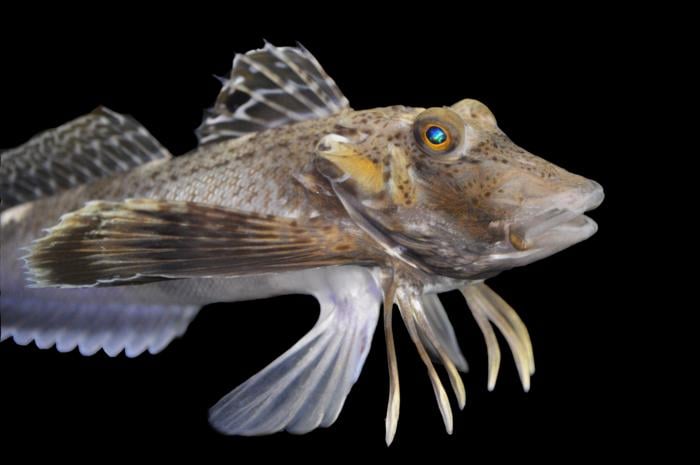Sea robins, bottom-dwelling ocean fish with leg-like appendages, are offering scientists new insights into how novel traits evolve. Recent studies from Harvard and Stanford researchers have uncovered the genetic and sensory mechanisms behind these unique limbs, shedding light on broader questions of evolutionary adaptation.
Summary: Scientists have discovered how sea robins use their leg-like appendages for sensory purposes and identified the genetic factors controlling their development, providing a model for studying evolutionary adaptations.
Estimated reading time: 5 minutes
In the vast ocean depths, an unusual fish scurries along the seafloor, using six leg-like appendages to navigate its environment. This creature, known as the sea robin, has caught the attention of researchers for its unique adaptation that blurs the line between fin and limb.
A team of scientists from Harvard University and Stanford University has recently published two groundbreaking studies in Current Biology, offering the most comprehensive understanding to date of sea robin biology and the evolution of their peculiar legs.
The Walking Fish: A Serendipitous Discovery
The journey into sea robin research began with a chance encounter at Cape Cod’s Marine Biological Laboratory in 2019. Corey Allard, a postdoctoral fellow in Nicholas Bellono’s lab at Harvard, was intrigued by these strange, legged fish.
“We saw they had some sea robins in a tank, and they showed them to us, because they know we like weird animals,” Allard explained. “Sea robins are an example of a species with a very unusual, very novel trait. We wanted to use them as a model to ask, ‘How do you make a new organ?'”
This curiosity led to a collaboration with Stanford researchers, resulting in two complementary studies that explore the sensory capabilities and genetic underpinnings of sea robin legs.
Sensory Organs Disguised as Legs
The researchers first sought to determine whether sea robin legs were indeed sensory organs, as previously suspected but never confirmed. Through a series of experiments, they observed the fish’s hunting behavior, which alternates between swimming and “walking” along the ocean floor.
Allard and his colleagues made a surprising discovery when they received a new shipment of sea robins mid-study. These fish, while similar in appearance, behaved differently from the original group. It turned out they had inadvertently acquired a different species of sea robin.
This serendipitous mix-up allowed the team to characterize two distinct species:
- Prionotus carolinus: Highly sensitive to touch and chemical signals, capable of digging to find buried prey.
- P. evolans: Lacks advanced sensory capabilities, using legs primarily for locomotion and probing.
The digging species (P. carolinus) possessed shovel-shaped legs covered in papillae, structures similar to human taste buds. In contrast, the non-digging species (P. evolans) had rod-shaped legs without papillae.
Genetic Blueprints for Leg Development
The second study, involving researchers from Stanford, the Max Planck Institute, and an Italian physicist, delved into the genetic mechanisms controlling sea robin leg formation and function.
Using advanced techniques such as transcriptomics and genomic editing, the team identified specific gene transcription factors involved in leg development. Intriguingly, some of these factors are also found in the limbs of other animals, including humans.
“Amy and Corey did a lot to describe this animal, and I think it’s pretty rare to go from the description of the behavior, to the description of the molecules, to the description of an evolutionary hypothesis,” Bellono noted. “I think this is a nice blueprint for how one poses a scientific question and rigorous follows it with a curious and open mind.”
Implications for Evolutionary Biology
The sea robin’s unique adaptation to life on the ocean floor offers valuable insights into how evolution allows for adaptation to specific environments. By studying these walking fish, researchers hope to gain a better understanding of how novel traits emerge and evolve over time.
The findings could have implications for our understanding of human evolution as well. Approximately 6 million years ago, humans evolved the ability to walk upright, a defining feature of our species. The genetic similarities between sea robin legs and other animal limbs suggest that studying these fish could offer clues about the evolution of bipedalism in humans.
As research continues, sea robins may prove to be a powerful model organism for comparing specialized traits across species and unraveling the mysteries of evolutionary adaptation.
Quiz
- What are the two species of sea robins mentioned in the article?
- Which genetic structures found in sea robin legs are also present in other animals, including humans?
- How long ago did humans evolve the ability to walk upright?
Answer Key:
- Prionotus carolinus and P. evolans
- Gene transcription factors
- Approximately 6 million years ago
Further Reading
Glossary of Terms
- Papillae: Small, nipple-like protrusions on the surface of an organ or tissue.
- Transcriptomics: The study of the complete set of RNA transcripts produced by the genome under specific conditions.
- Genomic editing: A type of genetic engineering in which DNA is inserted, deleted, modified or replaced in the genome of a living organism.
- Bipedalism: The ability to walk on two legs.
- Model organism: A non-human species that is extensively studied to understand particular biological phenomena, with the expectation that discoveries made in the organism model will provide insight into the workings of other organisms.
Enjoy this story? Get our newsletter! https://scienceblog.substack.com


